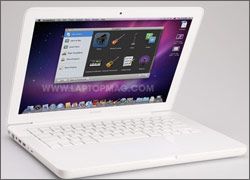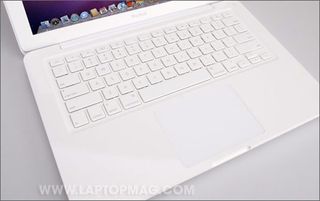Laptop Mag Verdict
Apple's elegantly redesigned MacBook offers strong performance, excellent ergononics, and good battery life for a reasonable price.
Pros
- +
Clean, elegant unibody design
- +
Excellent touchpad
- +
Good graphics performance
- +
Over five hours of battery life
- +
Fast boot time
Cons
- -
No SD Card reader
- -
Tinny speakers
Why you can trust Laptop Mag
Battery Life and Wi-Fi
On our LAPTOP Battery Test, the MacBook lasted 5 hours and 10 minutes in Snow Leopard. That runtime is nearly two hours short of the Apple's calim, and an hour less than the 13-inch MacBook Pro. However, this showing is about an hour longer than the thin-and-light notebook average, 100 minutes longer than the Samsung Q320, and about twice as long as the Studio XPS 13.
While we could not perform our standard Wi-Fi test on the MacBook, we never wanted for connectivity. Even at 100 feet from our access point, all the bars of the Wi-Fi meter were still filled. The MacBook also comes with Bluetooth 2.1 + EDR.
Heat

Click to enlarge
During our testing, we measured the temperature of the MacBook in several places: the touchpad got as hot as 82 degrees Fahrenheit, the space between the G and H key reached 92 degrees, and the underside of the notebook nearest the hinge got as warm as 97 degrees; it was definitely noticeable when we had the notebook in our lap.
Configurations

Click to enlarge
Unlike MacBook Pros, which let you choose different processors and screens, the only options Apple provides to consumers is to upgrade the RAM to 4GB for an additional $100; a 320GB, 5,400rpm hard drive costs $50 more, and a 500GB, 5,400rpm drive adds $150.
Software and Warranty
Aside from its excellent Snow Leopard operating system, the MacBook comes loaded with Apple's iLife '09 creativity suite (iPhoto, iMovie, iWeb, and GarageBand), and its Time Machine backup software. While we're glad it doesn't have any trialware on it, we would have liked to seen a word processor a little less rudimentary than Notepad.
Apple's standard warranty remains: one-year limited parts-and-labor and 90 days of toll-free, 24/7 phone support (Apple consistently aces our annual tech support showdown). The AppleCare Protection Plan, which includes three years each of parts-and-labor coverage and phone support, costs $249). To see how Apple fared on our Tech Support Showdown.
Verdict
Thanks to its stellar industrial design, superior ergonomics, and above-average performance and battery life, 13-inch MacBook ($999) is a compelling buy. This notebook costs nearly the same as Windows-based competitors (like Dell Studio XPS 13) but offers longer endurance. The main question for consumers is whether they spend the extra $200 on the 13-inch MacBook Pro, which has an SD Card slot, backlit keyboard, and a sleeker aluminum chassis. If you can live without these amenities, the new MacBook is a strong choice.
Performance
The MacBook's 2.26GHz Intel Core 2 Duo P7550 processor is the same as the 13-inch MacBook Pro, which is to say it has less power than the previous MacBook we reviewed (2.4-GHz Intel Core 2 Duo P8600 CPU and 2GB of RAM); in Geekbench, the 2009 MacBook (with 2GB of RAM) scored 3,464, which is about 50 points less than the 2008 MacBook. In Boot Camp mode (running Windows 7), the MacBook's Geekbench score dropped to 2,597, placing it between the Dell Studio XPS 13 (2,596) and the Samsung Q320 (2,834).
The MacBook scored 3691 in PCMark Vantage in Boot Camp mode; that's almost 600 points above the thin and light notebook average, 270 points below to the Dell Studio XPS 13 (which has 4GB of RAM), and about 100 points below the Samsung Q320 (which has a 2.53-GHz Intel Core 2 Duo P8700 and 4GB of RAM). Interestingly, the MacBook's score was about 500 points higher than the 13-inch MacBook Pro, which has the same processor and RAM. Anecdotally, we were able to have numerous tabs open in Safari 4, type this review in Google Docs while listening to music via Slacker, and watch episodes of "30 Rock" streamed from Hulu without a hitch.

Click to enlargeThe 250GB, 5400 rpm drive proved very fast, too. In Snow Leopard, it duplicated a 4.97GB folder of multimedia files at a rate of 27.8MBps; that's 7MBps faster than the thin and light average (in Windows 7, it was a much more pedestrian 14.9MBps). The drive booted to Snow Leopard in a speedy 26 seconds.
When transcoding a 114MB MPEG4 to AVI using HandBrake in Snow Leopard, the MacBook took 2 minutes and 12 seconds; that's over 5 minutes faster than the category average, and just 9 seconds slower than the 2009 13-inch MacBook Pro. When performing the same test in Windows 7, the time rose to 6:50, which is closer to, but still bests, the category average.
Graphics Performance
The Nvidia GeForce 9400M graphics card inside, the same as used in earlier MacBook Pros, was able to notch a 3DMark06 score of 2160 in Windows 7, which was almost identical to the 13-inch MacBook Pro, and nearly 60 points higher than the Dell Studio 14z, both of which have the same graphics card. However, it was about 450 points below the Samsung Q320 (which has an Nvidia GeForce G105M GPU).
In Far Cry 2 (Windows mode), the MacBook averaged 29 frames per second with the screen set to 1024 x 768, and the effects set to optimal; with the resolution at its max, and eye candy set to Very High, this number dropped to 8 fps. Both are in line with the thin-and-light averages of 20 and 9 fps, respectively, and in the same ballpark as the 13-inch MacBook Pro (25/8 fps), the Studio XPS 13 (26/10), and the Q320 (29/7).
Macs have long been touted for their excellent design and ease of use, but have been knocked for their relativey high cost. With its new $999 MacBook--a slightly stripped down MacBook Pro in a plastic chassis--Apple has delivered a notebook that not only offers similar performance to its higher-end cousin, but is now price competitive with Windows 7 machines that have similar specs. Considering its long battery life--not to mention Apple's excellent Snow Leopard operating system and first-rate customer support--the new MacBook is a strong buy. You just have to be willing to sacrifice some features.
Design
If you were to take a 13-inch MacBook Pro and replace the metal exterior with plastic, you'd pretty much have the MacBook. Its gleaming white glossy plastic interior and exterior--including the keyboard--continues the clean aesthetic of previous Macs, and hides fingerprints well, too. Like the MacBook Pros, this thin and light system also features a sturdy unibody construction. The result is a design that feels like it will stand the test of time.
While the aluminum-clad MacBook Pros with their black keyboards are definitely sleek, the all-white MacBook seems somewhat friendlier. The bottom panel, held in place by 8 screws, is coated in a soft light gray rubber, which keeps it from slipping around on a desk, and feels comfortable on your lap.
At 13.0 x 9.1 x 1.1 inches and weighing 4.7 pounds, the MacBook slightly larger and heavier than the 13-inch MacBook Pro (12.8 x 8.9 x 1.0 inches, 4.4 pounds), but isn't too great a difference that we couldn't carry it in our messenger bag.
Keyboard and Touchpad
Unlike the MacBook Pros, the MacBook's keyboard is not backlit; some concessions have to be made for the price. However, that seems to be the only concession. Not only is the island-style keyboard well-spaced, but the keys themselves were comfortable to the touch, and were snappy in response.

Click to enlarge

Click to enlargeApple has also brought the same touchpad as on its other notebooks: it doubles as the touchpad and the touch button. At 4.0 x 3.0 inches, not only is this trackpad the largest we've ever tested, but is very low friction, too. Like the 13-inch MacBook Pro, Apple's honed the design: we were able to effortlessly press down on the button without thinking about the fact that there's no dedicated touch button (nevermind two).
The multitouch gestures work smoothly, too. By pushing four fingers toward the top of the touchpad, we were able to fling windows up toward the top of the screen, exposing a clean desktop. When we used two fingers to zoom in and out of pages in Safari 4, the onscreen response was very quick. More importantly, it wasn't jerky and finicky, like the touchpad/button combo on the HP Envy 13. We were able to rest our left thumb on the pad and still move the cursor around without the notebook misinterpreting our movements.
Display and Audio
The 13.3-inch LED-backlit matte display on the MacBook has a resolution of 1280 x 800, and images were bright and crisp. However, this system doesn't have the same 60 percent greater color gamut as the MacBook Pro line, so photo editors will want to think twice. Vieweing angles were excellent from side to side, but the image degraded quickly when we tilted the screen forward. We didn't see any artifacts in darker scenes when watching videos streamed from Hulu, or when we watched a DVD.
While the speakers on the MacBook were loud, producing enough sound to fill a room, they were lacking in bass. Higher sounds, such as the drums and guitar riffs in The White Stripes' "Seven Nation Army" and the Yeah Yeah Yeah's "Gold Lion" tended to be overwhelming and somewhat harsh.
Ports and Webcam

Click to enlarge
The one area where we'd like to see Apple splurge a bit more is with its port and slot selection. The MacBook has two USB, mini DisplayPort, Ethernet, and a headphone jack on the left side; on the right is the slot for the SuperDrive DVD burner. Considering their ubiquity (you can find them on $300 netbooks), we'd prefer an SD Card slot, as well as at least one more USB port. The Dell Studio XPS 13, for example, has all of the above, as well as FireWire and HDMI.
When conversing with a friend over Google Chat, he said that our image was clear, and the embedded mic picked up our sound well, but the camera on the MacBook had a hard time adjusting to lower-light conditions.
Apple MacBook (2009) Specs
| Bluetooth | Bluetooth 2.1 EDR |
| Brand | Apple |
| CPU | 2.26GHz Intel Core 2 Duo P7550 |
| Company Website | http://www.apple.com |
| Display Size | 13.3 |
| Graphics Card | Nvidia GeForce 9400M |
| Hard Drive Size | 250GB |
| Hard Drive Speed | 5,400rpm |
| Hard Drive Type | SATA Hard Drive |
| Native Resolution | 1280x800 |
| Operating System | OS X 10.6 (Snow Leopard) |
| Optical Drive | DVD RW |
| Optical Drive Speed | 8X |
| Ports (excluding USB) | Mini DisplayPort, Ethernet, Combo Headphone/Mic Jack |
| RAM | 2GB |
| RAM Upgradable to | 4GB |
| Size | 13.0 x 9.1 x 1.1 inches |
| USB Ports | 2 |
| Video Memory | 256MB |
| Weight | 4.7 pounds |
| Wi-Fi | 802.11n |
